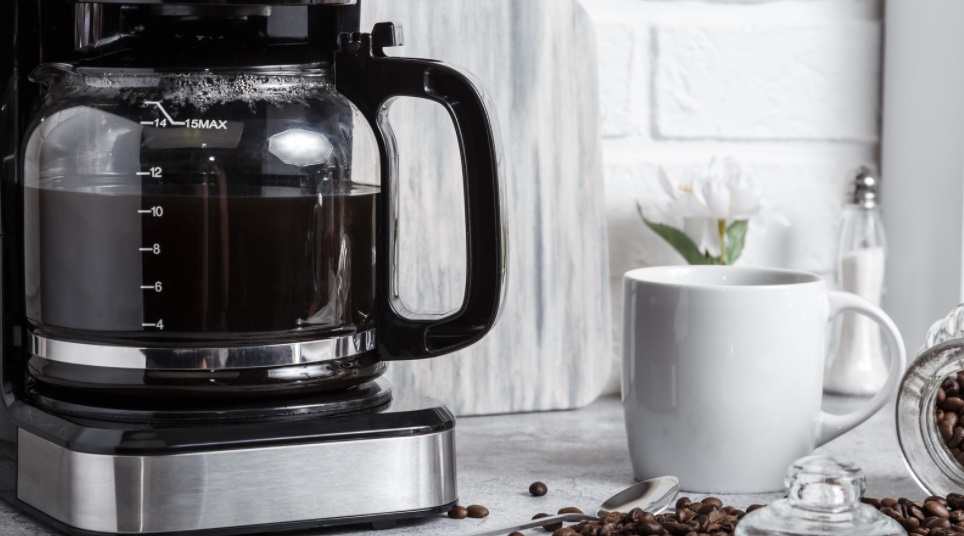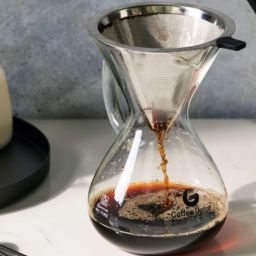
Have you ever wondered if you could make espresso in a drip coffee maker? While traditional espresso machines use high pressure to extract rich, dark coffee, a standard drip coffee maker doesn’t operate under the same mechanics.
However, with a few tweaks and an understanding of the process, you can come close to creating a strong, espresso-like coffee using just your drip machine. This guide explores the challenges involved and offers practical solutions to achieve a satisfying result.
Key Takeaways
- Optimal Coffee Grind and Tamping: To start, the grind of your coffee beans is crucial. A medium-fine to fine grind works best as it allows for better extraction without clogging the filter. While tamping in a drip coffee maker isn’t the same as in an espresso machine, you can lightly press the coffee grounds in the filter to increase the water’s contact time with the coffee, enhancing flavor extraction.
- Water Temperature and Coffee-to-Water Ratio: The temperature of the water and the proportion of coffee to water are key to mimicking an espresso’s strength and depth. Pre-heating the water to around 200 degrees Fahrenheit before adding it to the machine can mimic the hot, fast brew of an espresso machine. Also, using a lower ratio of water to coffee—such as two ounces of water for every tablespoon of coffee—helps concentrate the brew, enhancing its intensity and flavor.
- Adjusting Brew Techniques: Adapting your brewing technique can also make a significant difference. Consider modifying your drip coffee maker’s brew cycle to create a shorter, more intense extraction. Some machines have settings for a stronger brew, or you can manually interrupt the brewing process early to prevent over-extraction, which typically leads to bitterness.
Can You Make Espresso in a Drip Coffee Maker?
Yes, you can make espresso in a drip coffee maker, but it comes with limitations and significant differences from what you would get from a traditional espresso machine. The essence of espresso lies in its method of extraction: espresso machines use high pressure to force hot water through finely ground coffee, producing a concentrated and rich shot topped with crema.
Drip coffee makers, however, rely on gravity to pull hot water through the coffee grounds, resulting in a longer brew time and a lighter extraction.
Espresso machines typically operate at about 9 bars of pressure to extract coffee quickly and efficiently, achieving a rich flavor and thick crema. In contrast, drip coffee makers lack this pressure, which means they cannot extract the same flavor complexity or produce crema. The result is a coffee that is less robust and lacks the creamy texture that espresso enthusiasts cherish.
Despite these differences, with some creativity, you can hack your drip coffee maker to produce a stronger, more concentrated coffee that resembles espresso. One approach is to use a finer grind of coffee than usual, although not as fine as you would for an actual espresso machine to avoid clogging.
Increase the coffee-to-water ratio for a stronger brew—think more coffee and less water. Also, preheating your water before adding it to the machine can help mimic the hotter temperature needed for espresso extraction.
Step-by-Step Guide to Making Espresso with a Drip Coffee Maker
Creating espresso-like coffee using a drip coffee maker requires a bit of ingenuity and adjustment in the brewing process. Here’s a simple guide to get you started:
Step 1: Gather Your Tools and Ingredients
- Drip Coffee Maker: Any standard drip coffee maker will work.
- Coffee Grinder: Freshly ground coffee beans provide the best flavor.
- Coffee Beans: Opt for a dark roast for a flavor closest to traditional espresso.
- Water: Filtered water is preferred for the best taste.
- Thermometer (optional): To check water temperature.
- Scale (optional): For precise coffee measurement.
Step 2: Prep Your Coffee Maker
- Heat Water: If your coffee maker doesn’t get hot enough, preheat your water to about 200 degrees Fahrenheit. Use a kettle for this purpose.
- Grind Coffee: Aim for a medium-fine grind. Too fine and you risk clogging the filter; too coarse and your coffee will be weak.
Step 3: Adjust Coffee-to-Water Ratio
- Increase Coffee: Use about 2 tablespoons of coffee for every 6 ounces of water. This is double the usual amount for a stronger brew.
- Add Coffee to Filter: Place the coffee in the filter and gently tap it to level the surface, but don’t tamp as you would in an espresso machine.
Step 4: Brew Your Coffee
- Modify Brew Cycle: Start your coffee maker. If possible, stop the brew cycle mid-way for about 30 seconds to allow the coffee to “bloom” and then resume. This step mimics the pressure effect of an espresso machine by letting the coffee grounds expand and release their flavors.
Step 5: Serve Immediately
- Enjoy: Serve your coffee as soon as it’s brewed for the best flavor. Although it won’t have the crema that traditional espresso boasts, you should achieve a strong, concentrated coffee.
This method won’t replicate a true espresso but will give you a stronger, richer coffee than your typical drip brew. Adjust the grind size, coffee amount, and brewing time to your taste as you experiment to find the perfect “drip espresso” for you.
Alternative Methods Using Common Household Coffee Equipment
Exploring different brewing methods with equipment you might already have at home can bring you closer to the rich taste of espresso. Here’s how you can use a Moka Pot, French Press, and AeroPress to achieve a more espresso-like experience.
Using a Moka Pot
- Prepare: Fill the bottom chamber with water just below the valve and add finely ground coffee to the filter basket.
- Heat: Place the pot on a stove over medium heat.
- Watch: As the water boils, it will pass through the coffee into the top chamber. Once you hear a hissing sound, your coffee is ready.
- Serve: Enjoy a strong, espresso-like coffee. The Moka Pot is known for producing a concentrated brew similar to espresso due to its unique brewing method involving steam pressure.
French Press
- Coarse Grind: Use a coarse grind to avoid a muddy cup.
- Hot Water: Pour hot water (just off the boil) onto the coffee grounds in the French Press.
- Steep: Allow it to steep for about four minutes, then press the plunger down slowly.
- Serve: This method yields a rich and full-bodied coffee, though not as concentrated as espresso; it’s still stronger than regular drip coffee.
AeroPress
- Fine Grind: Use a fine grind of coffee.
- Hot Water: Add hot water to the coffee in the AeroPress.
- Press: After stirring, press the plunger down firmly.
- Serve: The AeroPress can make a coffee very close to espresso strength and flavor due to its ability to use fine grinds and achieve high pressure.
Common Mistakes and How to Avoid Them
Avoiding common brewing errors can greatly improve your coffee quality. Here’s how to sidestep some typical pitfalls:
Grind Size
- Too Fine/Coarse: Using the wrong grind size can lead to over or under-extraction. Espresso typically requires a fine grind, but for drip and French Press, a medium to coarse grind is suitable.
Over-extraction
- Brewing Time: If your coffee tastes bitter, it might be over-extracted. Reduce the contact time between water and coffee.
- Water Temperature: Too hot water can extract bitter compounds too quickly. Aim for 195-205°F.
Inadequate Water Temperatures
- Pre-heat: If using a manual method like a French Press or AeroPress, pre-heat your water to the correct temperature.
- Thermal Stability: Keep your coffee maker or pot warm before brewing to maintain stable brewing temperatures.
FAQs
Can regular coffee beans be used to make espresso in a drip coffee maker? Yes, you can use regular coffee beans to make espresso-style coffee in a drip coffee maker. However, for a richer and closer-to-espresso experience, opt for a darker roast and ensure the beans are ground finely enough to enhance extraction and flavor intensity.
How does the taste differ from real espresso? The taste of espresso from a drip coffee maker will differ significantly from that of a traditional espresso machine. Without the high pressure, the brew is less concentrated and lacks the characteristic crema. The result is usually lighter, with less body but can still be made strong and flavorful with the right adjustments.
Tips for maintaining your coffee maker when brewing espresso-style coffee.
- Regularly clean your coffee maker to prevent oil and mineral buildup, which can affect taste and function.
- Use filtered water to reduce scale accumulation.
- After brewing, always rinse the basket and carafe to remove coffee residue.
Final Thoughts
While you can’t replicate authentic espresso with a drip coffee maker, you can still brew a strong and concentrated coffee that may satisfy your espresso cravings at home. Be mindful of the grind size, coffee-to-water ratio, and brewing technique to optimize your results. For those without an espresso machine, experimenting with these adjustments can provide a delightful and robust coffee experience.









